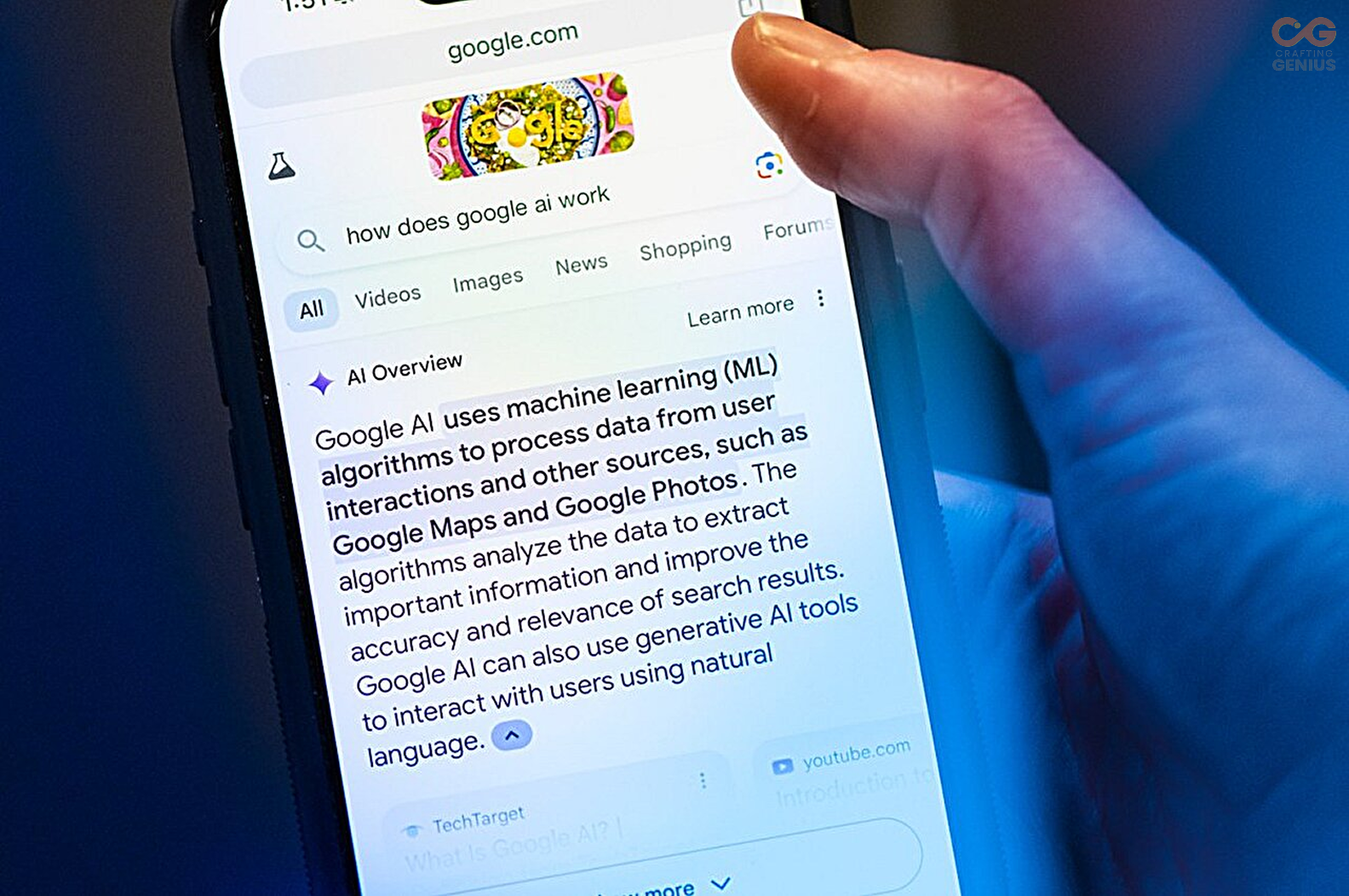Machine Learning in SEO: Why the Google Algorithm is Evolving in 2025 and Beyond
Table of Contents
INTRODUCTION: SEO Has Become An AI Playground
Search Engine Optimisation (SEO) is going through a paradigm shift, and it is evident that AI is now reshaping the future of SEO worldwide. Google has gone beyond keywords and backlinks to Machine-Learning and Artificial Intelligence-based Google Algorithms. They have become more interested in knowing how users act, what they want to know, and what their intent is at a substantial level. With Machine Learning, Google is able to analyze an extensive amount of data, adjust to dynamic search patterns, and present significantly relevant results in real-time.
Based on identifying the natural language to anticipate the requirements of the user before a query is even finished in the search box, AI-based Solutions are transforming content, as far as its discovery and prioritization are concerned. The trend implies that SEO Professionals have to get out of the static strategies and implement data-based, intent-driven strategies to stay in the game. As Google Algorithms will continue to change in the future, the knowledge of such advanced AI systems cannot only be gainful but also an essential factor to have sustainable Digital Marketing strategies.
Since RankBrain in 2015, to AI Mode in 2025, the Google Algorithm is not just matching keywords; it involves complex Machine Learning. It can now grasp context, intent, and multimodal input and provide conversational, AI-generated responses and fittings on latent real-time search optimization.
As per XPONENT21, AI Overviews (AIOs) can be seen in up to 49 percent of all Google searches as of May 2025, and thus represent a dominant aspect of search results. Ahrefs research proves that since the March Core Update by Google in 2025, the number of AI Overviews in the search results has increased significantly by 115%.
Role of Machine Learning in the Google Algorithm
What is Machine Learning in SEO?
The concept of Machine Learning is how computers can learn patterns and enhance the decision-making process without any programming. In SEO, it can assist the algorithms used by Google to interpret the large amounts of information, including the User Experience and Search Queries, and provide more appropriate and superior results.
Rule-based to Learning Based Search
Previously, this was what Google had been using in its algorithms, where it was entirely dependent on hard-coded rules- ranking factors were fixed, and to make changes, it had to be done manually. By contrast, contemporary AI- and machine-learning-driven systems are now actively:
- Discover and understand new ranking signals through direct user behavior in real time.
- Test and adjust content rankings dynamically and continuously according to engagement measures.
- Adjust to changing language dynamics, trending topics, and changing search intent instantly.
Such a transformation creates a radical change in rule-based, inflexible reasoning to dynamic, self-optimizing search behaviour.
The importance of machine learning
Machine learning makes it possible to ensure actual personalization on scale, and Google can handle millions of variables at once. These factors consist of device type, geographic location, search history, browsing activity, and even speculated emotional tone- and lead to highly personalized Search Engine Results Pages (SERPs).
The effect of personalization is enormous: researchers discovered that an average of 11.7 percent of search results in Google vary per person because of personalization factors such as whether a user has logged in or not and the IP used, as per WIKIPEDIA. Individually, SEOClarity 2025 survey data shows that 86% of respondents claim to use AI as an active part of their strategy today, and that the majority of respondents noticed significant boosts in terms of improving SEO performance and engagement.
This shift is both a game-changer in the world of SEO and a revolution in how SEOs measure success because it no longer falls within the domain of the keyword or the link-based approaches to do the work.
Important Google Algorithm Changes Powered by Machine Learning
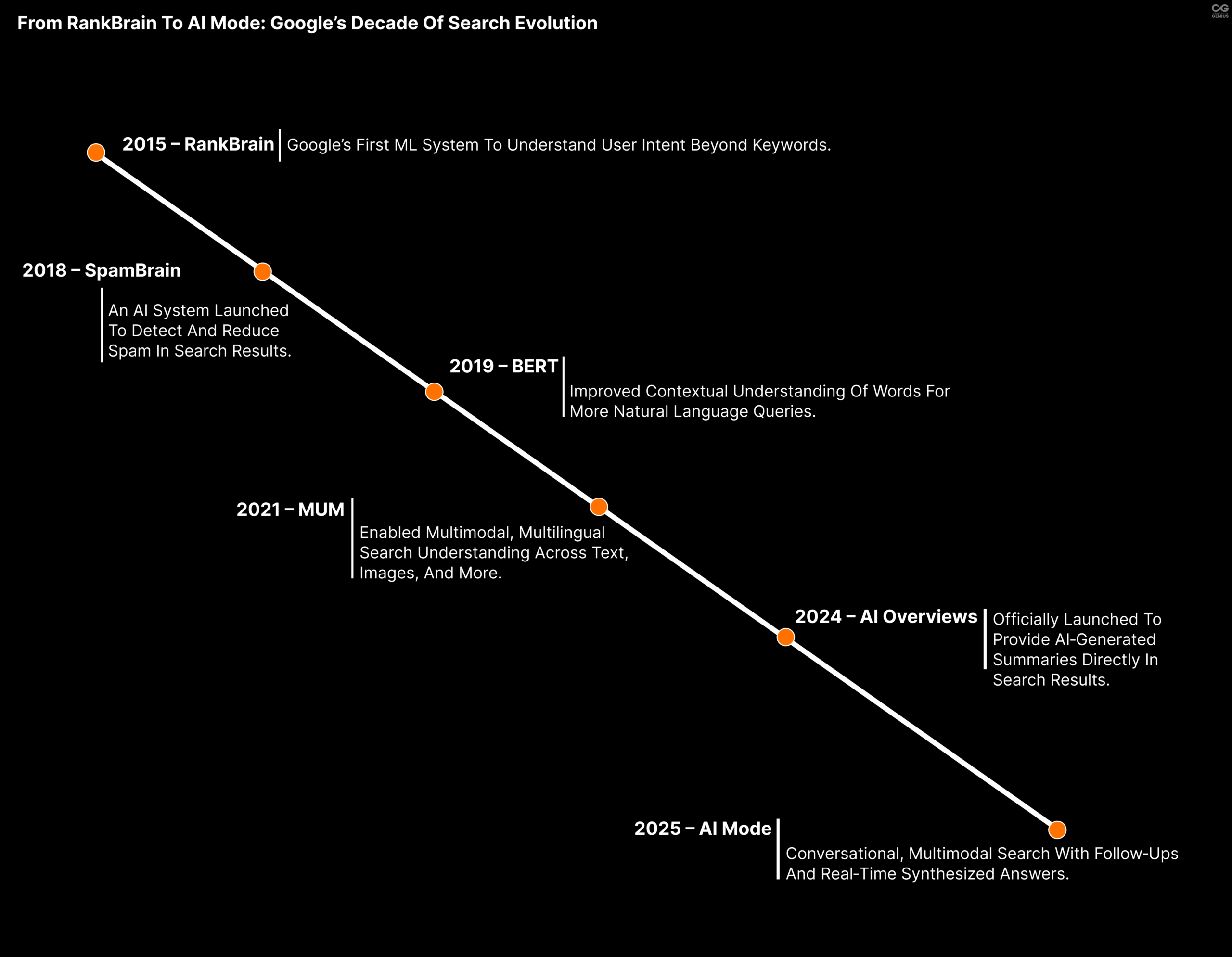
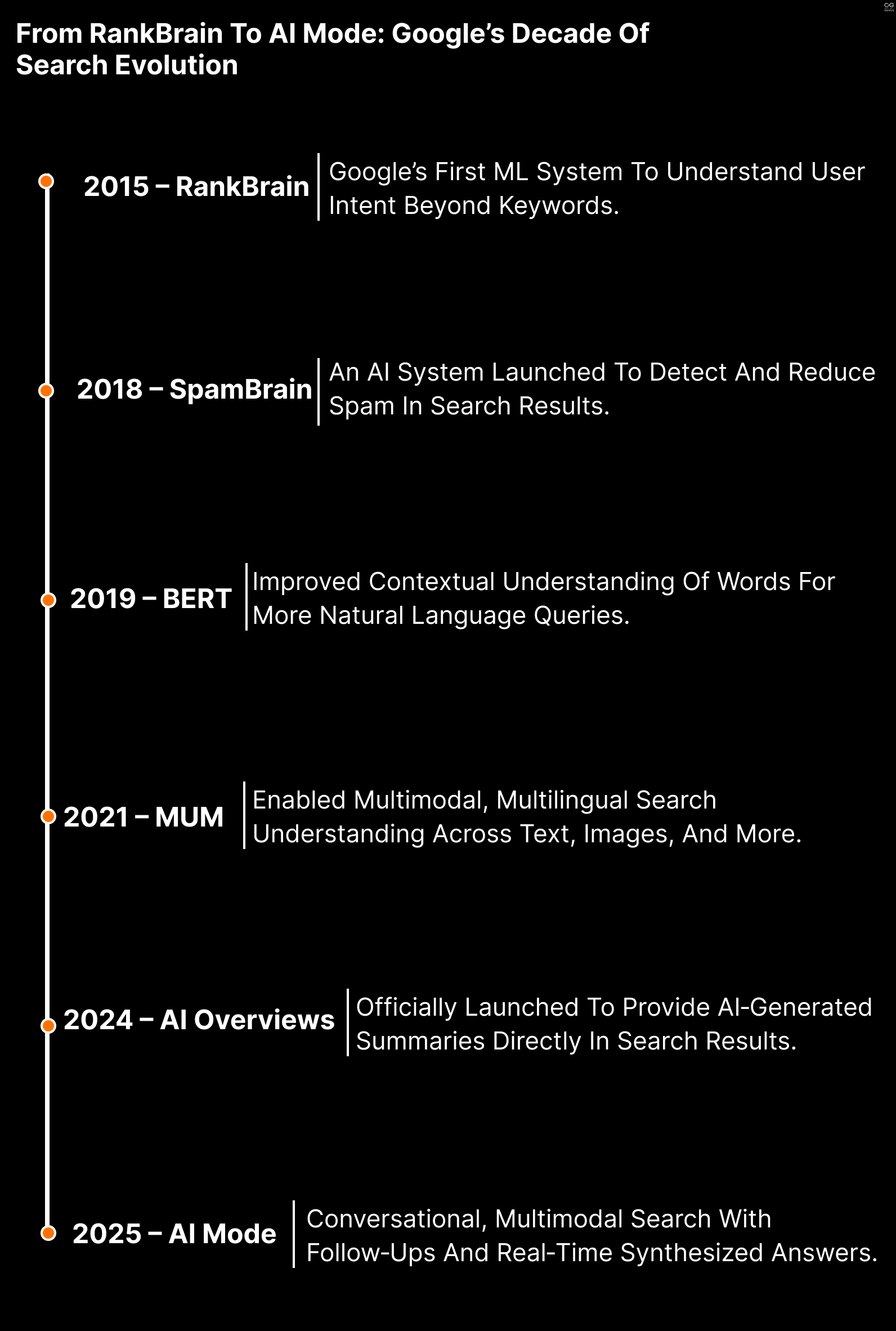
www.craftinggenius.in
RankBrain: The First Machine Learning System of Google Visual
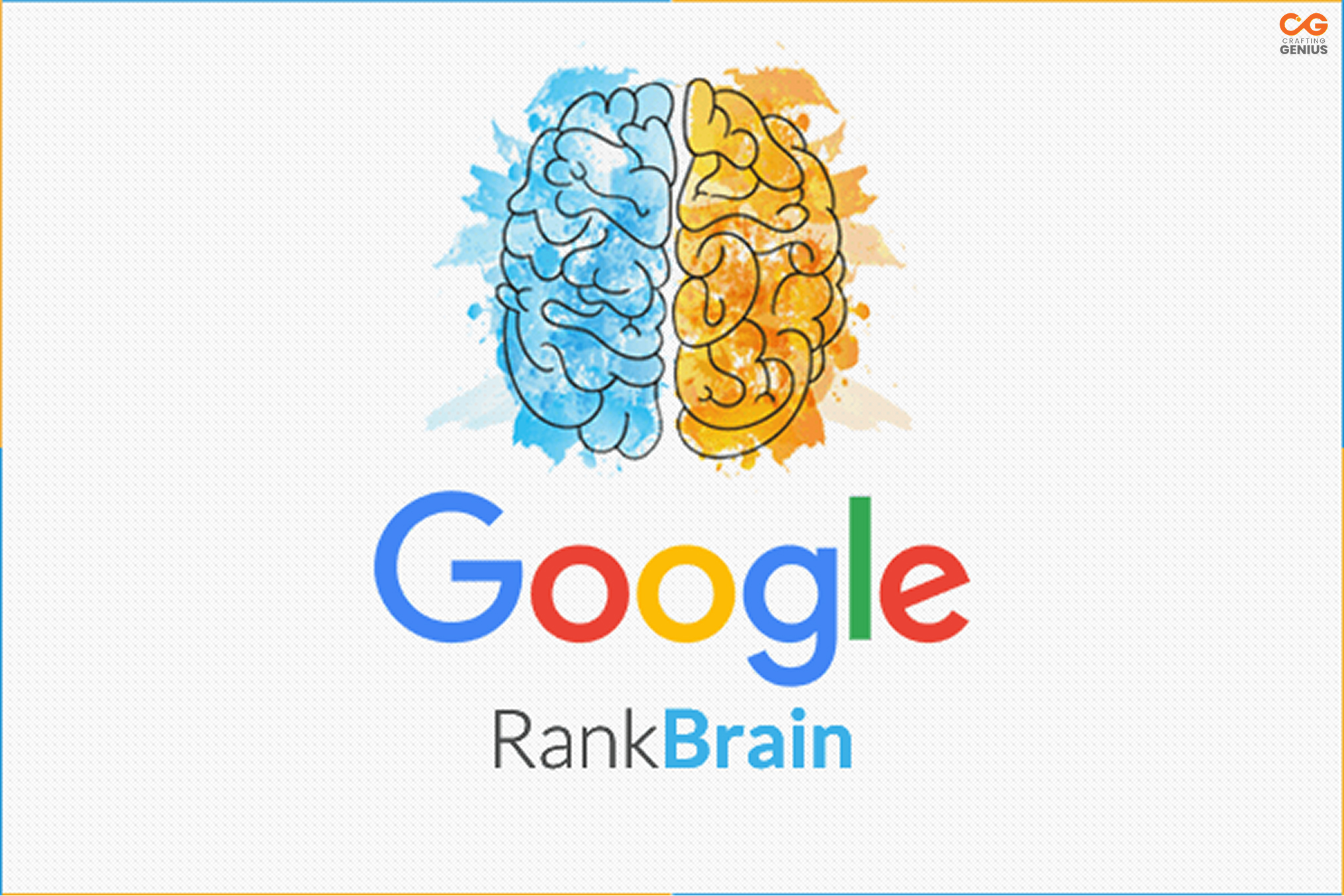
RankBrain was the initial AI model in Google ranking introduced in 2015, as mentioned in the Semrush Blog. It implements Predictive Analytics in the interpretation of previously unseen or vague queries. RankBrain modified the manner in which Google determines relevance-that is, it gave importance to the user intent rather than a match in exact keywords.

www.craftinggenius.in
Key characteristics of Google RankBrain
- RankBrain is a machine learning model that understands the meaning behind searches instead of keyword matching.
- It is efficient in handling unfamiliar searches because it guesses what users want.
- It dynamically updates the rankings on the basis of user engagement measures like the click-through rate and time spent.
- It leads to the increased semantic understanding of various concepts and synonyms that Google uses to display more relevant and context-appropriate search results.
SpamBrain: Protecting SERPs against Low Quality Content Visual
SpamBrain, the spam detection system built by Google, is now more vigilant. It detects unnatural link-building, overuse of keywords, and low-quality content. Since Google is putting pressure on AI-generated content spamming, quality is of high importance. These are the main capabilities of SpamBrain, a Google AI-based spam detection system aimed at identifying and eliminating spam:

www.craftinggenius.in
Useful Features of SpamBrain
- Self-learning, adaptive platform: SpamBrain actively adapts over time using machine learning to detect not only known forms of spam, but also new and emerging spam tactics, such as paid links, cloaking, scraped content, and hacked or low-quality pages.
- Real-time crawl-time spam detection: SpamBrain detects spam at crawl time, before it passes into indexing and search resources.
- Highly effective link spam detection: Google says that in 2022, SpamBrain caught 50 times as many link spam sites as the last link spam update, and dramatically increased the detection capability of hacked and manipulative links.
- Spam coverage massively increased: with the number of identified spam sites multiplying by 5 times in 2022 compared to 2021 and 200 times relative to when it was launched in 2018, which led to more than 99% of the Search visits not being spam sites, according to SEOZOOM.
BERT: Deep Learning with NLP

www.craftinggenius.in
The BERT (Bidirectional Encoder Representations from Transformers), which was introduced in 2019, according to IBM, enhanced the Natural Language Processing feature of Google. It allows Google to interpret language nuances, particularly prepositions and context. In 2025, BERT will be pivotal in grasping long-tail queries and voice search.

www.craftinggenius.in
Key Characteristics of BERT
- Bidirectional Context Understanding: Rather than reading the text once (left to right and right to left), BERT reads a sentence in both directions in order to comprehend the context of the entire words in the sentence.
- Better Natural Language Processing: Makes Google aware of the vocabulary of conversational queries, such as prepositions, word order, and so on.
- Improved Processing of Long-Tail Queries: BERT is efficient in processing complex long-tail, specific, and natural-language search queries.
- Contextual Word Embeddings: Words are interpreted using their surrounding context, making interpretation less ambiguous.
MUM: Understanding And Answering Multimodal Queries
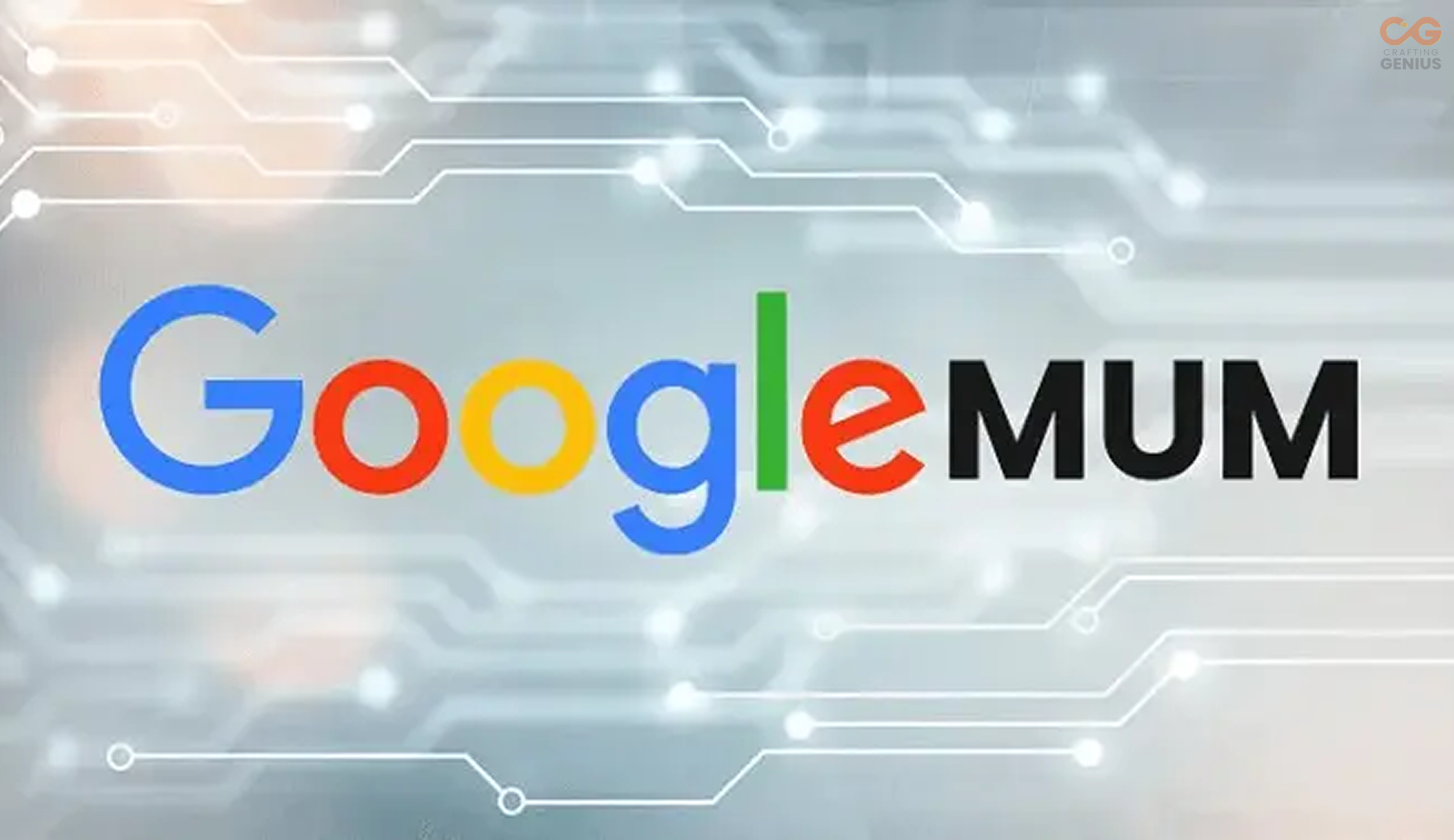
www.craftinggenius.in
Multitask Unified Model (MUM) is supposed to be 1000 times stronger than BERT to comprehend images, text, and various languages simultaneously, as per Search Engine Journal. In 2025, it will enable Google to unify information in different forms so that it answers questions even when the contents are separate in languages and media.

1. MUM Reads Various Forms (Multimodal Power)
Compared to older models, which consider only text, MUM can mix text, images, video, and audio in one search and provide more informed and practical results that are more intuitive.
2. MUM has Global+Contextual Intelligence (MUM thinks beyond languages and keywords)
MUM is trained in 75+ languages, knows the intent of such a complex query, and can draw the relevant information from anywhere in the world, even when in a different language or format, as per Google.
The Reason It is Powerful in this Context:
- Multilingual Mastery: Combines local to national sources in the linguistically diverse regions of India.
- Cross-Format & Context Integration: analyzes the text, deals with multilingual references, and merges disjointed information into stable, reliable outcomes.This presents MUM as a blueprint of next-generation intelligent information systems beyond search.
AI Overviews
Introduced in 2024, AI Overviews offer a summary of many sources at the start of search results by aggregating information about multiple sources to address complex questions in a concise and effective way.
Key Features:
- Follow‑up prompts after conversational search
- Real-time, synthesized, and contextual responses
- Multimodal communication through messages, speech, and pictures
- Greater interconnection with AI agents to aid in tasks
- Personalized, interactive responses minimizing dependence on links
AI Mode
AI Mode, launched in 2025, is an interactive and conversational assistant through Google Search based on Gemini 2.5, which provides real-time responses generated by AI.

www.craftinggenius.in
Key Features:
- Produces brief, contextual summaries of topics
- Gathers data and information based strictly on authoritative and varied sources
- Supports multimodal inputs such as images and text
- Minimizes the necessity of clicking several links
- Focuses on relevance and structured data as visibility factors
The effect of Machine Learning on SEO
Content Optimization
High-quality, relevant, and user-friendly content practices are now prioritized by the AI algorithms. The aim of writing should not be dedicated to search engines; it should be dedicated to readers. Google Featured Snippet Algorithm favors structured answers, and the Blue Link Algorithm ranks based on depth, intention, and topic authority.
Analysis of Search Intent
Recent SEO is based on the idea of attracting and satisfying the user’s needs. AI models are capable of determining search intent, which may be informational, transactional, or navigational. Keywords should be matched with all points of the user journey. Predictive analytics also enhances this matching in order to have a better view and interaction.
UX and Personalization
Personalization has become a major ranking factor. Direct impact on rankings is the user experience (UX) of mobile-friendliness, the speed of loading, and Core Web Vitals. Systems powered by AI tailor SERP to the people; this is why personalized and intent-based content is not only increasing traffic but is also helping to be more relevant.
Spam Detection & Link Evaluation
Google algorithms are becoming more context-based to evaluate link quality. The links that come to valuable content or Knowledge Panels are more weighted. SpamBrain identifies and removes the kind of backlinks that are of low quality, and quality link-building and genuine digital partnerships are crucial to successful long-term SEO.
SEO marketing in the AI world
Write Authoritatively, Not With Keywords
Keyword stuffing is obsolete. The recent search engines based on AI are giving preference to the so-called semantic SEO and the content that proves EEAT: the expertise, experience, authority, and trustworthiness.
Add structured data markup to allow the algorithms to understand entities, context, and relationships within your content and increase the likelihood of being featured in rich results in Google Search.
Optimized to Intent Not Just Search Volume
Now, user experience can be used as a ranking signal. Check the speed, mobile friendliness, and accessibility of Core Web Vitals pages using Google Lighthouse.
Such insights enable SEO experts to develop content that fulfills the needs of users in an effective manner, and also to fulfill the ever-changing ranking factors as determined by Google in terms of its AI-driven value set.
Better UX: Faster, Better Design and Accessibility
Now, user experience can be used as a ranking signal. Check the speed, mobile friendliness, and accessibility of Core Web Vitals pages using Google Lighthouse.
Easy-to-use interface, structured navigation, and proper format are useful to what the users will like as well as to the search engines.
Use AI in Content Planning
Leverage tools to cluster keywords, brainstorm, and generate metadata with tools like Jasper, Frase, and ChatGPT.
A mix of both efficiency in AI and human wisdom will result in high-quality, pertinent, and scalable content strategies.
Master Brand SERP Optimization
AI is getting to know brand signals. To enhance your Brand SERP Optimisation, invest in schema-rich content, proper citation consistency, and Knowledge Panel, review, and other authoritative listings visibility. This improves authenticity and searchability.
Master Brand SERP Optimization
Google RankBrain
Google’s ML system that interprets queries and adjusts ranking based on user intent and behavior
Google SpamBrain
An AI-based system that detects spammy content and manipulative tactics to improve result quality.
SEMrush Copilot
Provides AI‑powered SEO recommendations, competitor insights, and predictive ranking analytics.
Surfer SEO
Uses AI to analyze top‑ranking pages and gives optimization guidance for better rankings.
SE Ranking
Offers AI-driven audits, ranking tracking, and an AI Overviews Tracker for Google’s AI search summaries.
RankIQ
Focuses on keyword discovery and content optimization using AI to predict ranking opportunities.
Alli AI
Automates on‑page SEO improvements like metadata, schema markup, and internal linking using AI.
Future Trends: What Will Happen Next in AI & SEO?
Voice and Visual Search optimization
In 2025, voice search is used by around 20.5 percent of internet users all over the world, as mentioned in DemandSage. In order to take advantage of this shift, brands need to optimize around conversational long-tail queries and augment the visual metadata: structured tags, alt tags, etc., in voice-first and visual-search applications.
The Emergence of Multimodal Search
A new feature, MUM (Multitask Unified Model) of Google, can interpret text, images, and other forms of data at the same time, facilitating a more comprehensive, integrated search. Strategies must involve video SEO, image optimization, and audio ready to be surfaced on various query types and into the emerging multimodal SERPs of Google.
Is AI-Generated Content a Blessing or a Curse?
In an update issued in January 2025, the Search Quality Rater Guidelines of Google advised raters to use the “Lowest” rating for content created or generated by automated or generative artificial intelligence tools when they do not add value. This serves as a lesson that states that it is dangerous to rely too much on AI-generated content that is not refined and that has no depth of knowledge.
The SEO is Still a Human Job
As much as powerful predictive analytics are needed, actual engagement and confidence of the user with technology still depend on human touch-tone, story, empathy, and innovation. The 2025 Search Quality Rater Guidelines state that human understanding of how to rate the quality of the content and guiding the development of the Google algorithms is still needed.
Conclusion: Adapt, Innovate, Lead
SEO professionals need to combine human creativity with the power of AI-driven insights to become successful. What comes next is no longer a matter of keywords or links; rather, it is a matter of comprehending context, intent, and user behavior more than ever before. The strategy is characterized by high-quality, consumer-centric experiences, structured content, and intelligent application of machine learning.
SEO will be intelligent, intuitive, and integrated in the future. Embrace the change, and you will reach new heights in terms of visibility, but those who fail to improve their methods in order to keep up with the times will be put at risk.
Takeaway
Learn the 2025 Google Quality Guidelines, the ability to Write Content That Rank and Resonate
Are you prepared to earn the confidence of Google in 2025? Let us make your content unstoppable.

